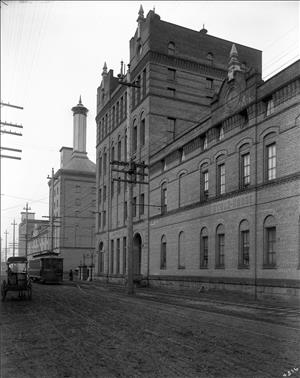This file contains Seattle historian and photographer Paul Dorpat's Now & Then photographs and reflections on Georgetown's historic Rainier Brewery. Georgetown became a neighborhood of Seattle when it was annexed in 1910.
Rainier Brewery
In 1903, Washington State photographer Asahel Curtis began recording the then brand new Seattle Malting and Brewing Georgetown plant. For his first return of many, Curtis struck this vertical “portrait” view of, left to right, the Malt-House (with the Moorish minaret chimney), Brew House (with its twin ornamental tops) and Stock-House on January 25, 1904.
The brewery continues far to the right out of the Curtis frame reaching a monumental length of 885 feet. By 1904, this was the largest brewery west of the Mississippi River and with addition upon addition through 1912 it became “world class” – the sixth largest in the world. For a time before Washington State introduced prohibition in 1916, the Georgetown brewery was the largest industrial establishment in the state of Washington.
In 1904, Georgetown incorporated -- a “company town” safeguarding the business interests of its brewery. Company superintendent John Mueller was soon elected both mayor and fire chief. The number of taverns and roadhouses doubled, and by 1905 it required 25 horse teams to daily fill the Seattle appetite for Rainier Beer, the primary label of the brewery. That year, the brewery employed more than 300 men. There was room to build worker homes on beside the Duwamish River that then still curved through Georgetown.
I have pulled most of these details from an essay written by Georgetown activist Tim O’Brian and architect Blair Pessemier in 1989 for successfully adding the Georgetown Brewery to the official register of city landmarks. This Curtis print accompanied their application. It illustrates beautifully their point that the oversized brewery is analogous to a medieval Cathedral, both in its form and function. When new and intact -- as we see it here -- it dominated Georgetown and its citizens as if to say, to quote O’Brian/Pessimier, “We come to work" rather than "We come to pray.”

